You might have seen your grandparents growing pumpkins in the family garden when you were a child in the growing season, and then you carve them into jack-o-lanterns on the 31st of October. Do you feel the smell of baking pies in the oven?
Now when you grew up you wish to plant pumpkins, although you can allow only container gardening in your apartment? At least you have a balcony or a patio to start your new hobby. Can I grow a pumpkin plant in a pot? Of course! Growing pumpkins is what we can manage doing!
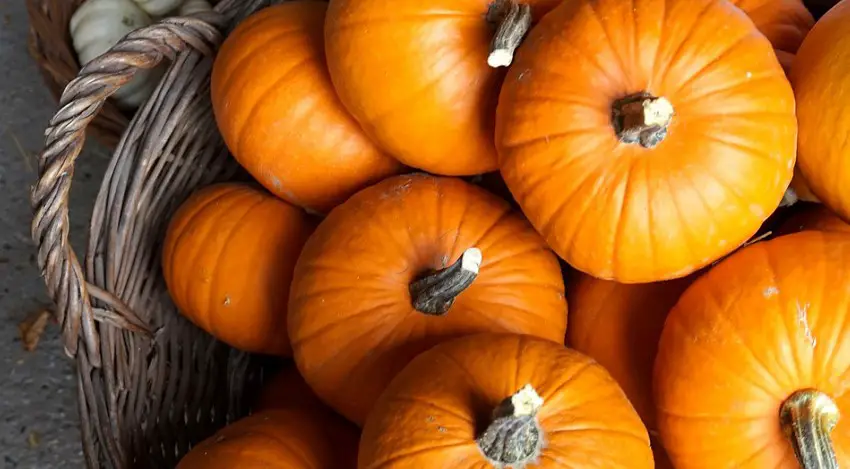
No worries!
If you have an intention, some pumpkin seeds or pumpkin plants, potting soil and a patio or a balcony with full sun access – you are in the plant growth process! How big of a pot does a pumpkin plant need?
Growing pumpkins in containers is not as difficult as it may seem because these vegetables are quite adaptive.
These are actually the easiest fruits to grow.
Look through the guide on how to plant a great harvest in your mini-garden and if you follow the advice in this article in 100-120 days you can harvest the vegetables!

Go through the steps of growing pumpkins in a container garden:
- Purchase a good container.
- Buy seedlings.
- Select the pumpkin from the pumpkin variety. There are miniature pumpkins too, it is fun, by the way, to use them as decorations.
- Use fertile or rich soil to grow pumpkins in containers.
- Before planting seeds, make sure you keep the soil moist.
- Find a sunny place for pumpkin pots.
- Plant some pumpkin seeds.
- Water pumpkins.
- Use slings if you grow large pumpkins. Container grown pumpkins will need a shaped trellis.
- Trim the leaves when they are out of the pumpkin pots.
- Harvest in the fall.
Growing pumpkins in details
When to plant?
So, you came home with containers and the intention of harvesting pumpkins. This is your start to growing pumpkins! Make sure the season is right. Pumpkins are better to be planted in the second spring month (April) or late May, as the temperature should be comfortable for the vegetables.
Follow the instructions on the seeds box to follow the dates, climate features and various requirements of the pumpkin.
The later you plant, the later the harvest is.
However, some of the varieties can be harvested twice over the period. Fertilizers can accelerate the process too.
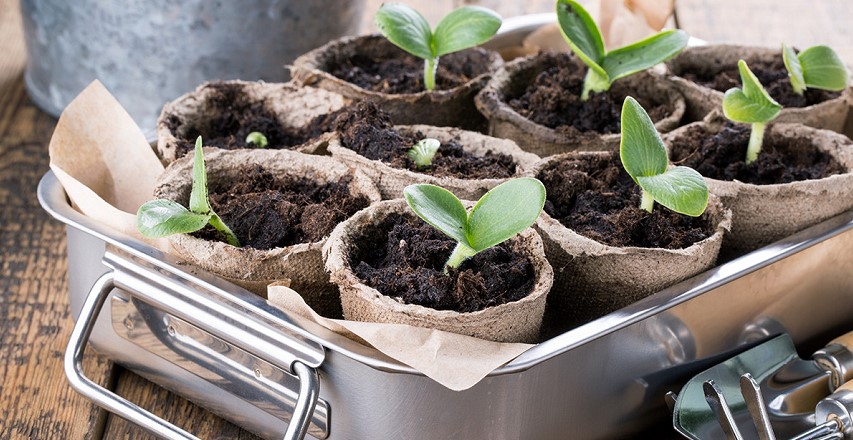
Purchase a good container to grow pumpkins
Features of the vegetable are that roots might grow quite far, and the size of the container will matter here. Unfortunately, if the size is small to grow a pumpkin, it will die. Ideally, if you are planning to grow pumpkins for Halloween decorations, you will need to buy a 10-gallon pot or 45 litres container for pumpkins on your patio.
Other than that, grow mini pumpkins for cooking and more comfortable storing at home.
The smallest ones can be used for decorations if you are a fan of Halloween celebrations, and the balcony will look better with the orange spots in between the leaves.
When size matters
Can you grow pumpkins in a 5-gallon bucket?
For smaller pumpkins, such as mini pumpkins, the size of plastic containers can be less correspondingly.
Some creative gardeners use small children’s swimming pools as they are broad and flexible. The pools can be easily drained, as pumpkins do not like water too much.
When it comes to decorations, though, you should not economize on container purchasing, as they are part of the process of the art installation.
Pumpkins grow in wet soil, try to keep a balance – do not keep thirsty plants but avoid overwatering.
Later we will talk about the watering process and soil selection. But before that, please make a decision on what type of pumpkin would fit better to your container and the balcony itself.
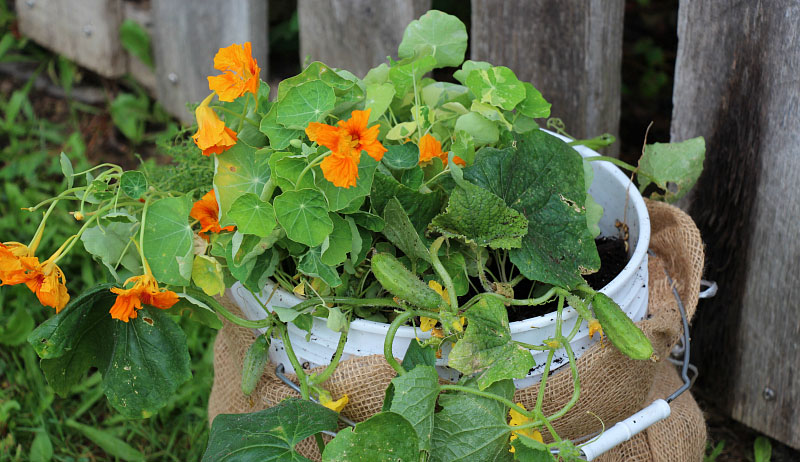
Here is the list of pumpkin varieties:
- The First Pumpkin: initially used to feed cattle and cook pumpkin pies. The taste is not that expressed whether you boil it or use it in soups. In our opinion, this is the worst choice for growing pumpkins in containers at home.
- New Moon: by the name, you can guess it is a thick, white-coloured pumpkin. Some of them might have stripes on the body, but the color does not affect the taste.
- Prizewinner: Pumpkin rind in this type is that sick, so you will need a sharp knife to cut it. It is super big and weighs up to 77 pounds. Containers must be huge to grow such a giant! Though, these plants produce one or two fruits per stem.
- Baby Boo: The Baby Boo is usually pale white and tiny, no bigger than 1.2 inches. People produce musical instruments from baby boos. They are filled with sand or small stones to produce sounds after the inner side was taken out and the body of the vegetable is dried well.
- Sugar Pie: the best choice for home cooking as it is sweet and used to produce cakes and cookies. Good for people with diabetes and are frequently used in special diets as do not require sugar while cooking.
- Jack-o’-Lanterns: too famous to describe. None of the Halloween parties in the United States of America will be celebrated without at least one such type decorated with candles and carved masks and faces. The legend of a lost head of a guy named Jack is closely connected to this pumpkin.
- Jack-Be-Little: easy to grow, has both male and female flowers. Pollination happens more often than, and harvesting might happen twice over the season. Takes the most popular place among all in our recommendations as despite it might take more time to grow, more money to buy doubles your harvest and if there was a mistake in the first round you can recover during the second.
Prepare a sunny spot for the comfortable soil temperature
Pumpkins require at least 4-6 hours of direct sunlight on the plants every day. To provide this thing over the spot you put the containers in before growing pumpkins, as moving the pots will be heavy.
We mean you should find a place before purchasing the container even and observe the daylight for several days to ensure the amount of direct sunlight on the pots.
As leaves are spreading around, a small space will not be the best choice either.
Plant grow
It is better to keep one container on the balcony or patio if there is not enough space for pumpkins to grow in comfortable conditions. When preparing the soil one should consider its temperature which should be between 69° F (21° C) to 95 °F (35 °C).
If you live in a village or a small town where the soil is not a problem, try digging some from the Central Park or the neighboring yard. But if you are a city dweller – you better rely on the soil sent in the flower shops.
To keep nutrients in the soil balanced, fertilizer must be bought too. Do not risk adding compost to the soil in pots if you grow pumpkins for the first time in your life!

Limited space gardening tips
Organize several storeyed constructions if there is no opportunity to put all huge containers in one raw. Rope the containers one by one to build a hanging construction from the top of the balcony down to the ground.
The ropes will serve as supporting ways for the hands of female flowers too.
Water deeply the upper part of the construction, letting the cascade of water pour down to the rest of the pumpkins.
Pumpkin plants
With a great variety of online suggestions, you will not have trouble selecting the right plant. The only thing to consider should be the size of your pot, as you are growing pumpkins in containers.
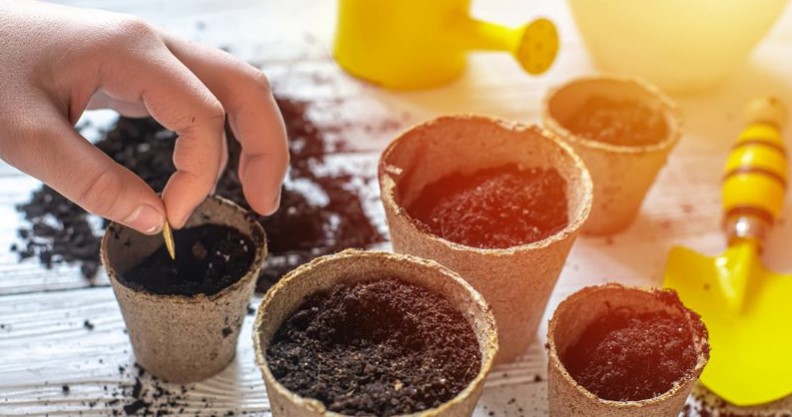
Growing pumpkins
Yet, it might take longer to grow it from the seed, it is likely it will show dark leaves in 2 weeks after planting it into moist soil down to 1-2 inches or 2-3 cm. If you dig it deeper, it might be difficult to grow and it can rot.
If you bought seedlings already and planning to transplant them into your containers – be careful!
You do not want the shock for the vegetables, as the young plants are fragile. Simply dig the pumpkin plants in the biodegradable pots, water them, and use low-nitrogen fertilizer. The pots will rot, but the pumpkin roots will not be disturbed.
A shape trellis and pumpkin vines
After the pumpkin plant is about 5 inches tall, it might need support. In about two weeks after that, your plants will need a big and durable trellis to support pumpkin vines.
There are many shapes and sizes of garden trellises: arbours and pergolas are usually tall and tunnel-like. Once you can DIY trellises and keep them as a family heritage.
How to make your pumpkin happy?
Now, when your pumpkin is growing in plastic containers, you need to take care of the conditions for pumpkins to grow successfully. Here is how to maintain it:
Water enough
Frequently water the plants as you would do with cucumbers, melons or bush beans. To plant pumpkin, people need at least one inch of water a week. So, pour the pumpkins often enough!
Be careful not to overwater the plants or do not pour liquid when it is too sunny in the middle of the day. The best time to water the pumpkins is in the morning or closer to the evening.

Use cover material to mulch the pumpkin plants
In the early spring, the coverage might help to keep moist soil and stable temperature to plant pumpkins. Cover the plants when they are quite short (1-2 inches) to let less liquid evaporate. The greenhouse effect will effectively contribute to the moisture level in summer and keep warmer temperatures early in spring.
When organic matter
To receive a decent number of pumpkins, and heavy feeders, you are expected to use fertilizers. If you followed our advice since the beginning, then the composed wastes are already in the pots.
Further, when the first green leaves appear, you need to support the growth by adding “food” for pumpkins.
Month by month decrease nitrogen use depending on pumpkin varieties. Use 5-15 -15 fertilizers once per two weeks.
Pollination brings fruits
Pollination is a process by which bees fly from a female flower to a male flower and spread the pollen. To fully ripe fruit, pollination is significant. However, you can do it yourself after careful analysis of the flowers.
Gently move the pollen to the ovary from male flowers to female ones using a cotton swab. Female flowers are usually born earlier than male ones. Congratulations! You are not worse than a bee now!
Pests and diseases
Your happy vegetables might be eaten by the insects when they are growing or fall down from the powdery mildew. To avoid it, keep the vines dry and away from cucumber beetles that destroy pumpkins faster than it grows.
The plant may die if infected by phytophthora blight if the roots lose color or the Squash mosaic virus can kill your fruit. These are viruses spread by insects.
Aphids, cucumber beetles and squash bugs
Have you ever seen yellow stripes on the leaves of a vegetable? These should be aphids eating leaves. Soft bodies of which secrete a harmful substance that later leaves necrotic spots on the plant. Gardeners usually knock off the insects with water or collect them manually. Neem oil is another measure to control the population of aphids.
Similarly, cucumber beetles leave scars on plants, but knocking them off is not the best solution. These insects can hide in the soil and emerge next year when it gets warmer.
Squash bugs are gray and yellow insects that can turn plants into wilt dry leaves before you will be able to harvest the fruits. This is the most dangerous type of pest as it not only hides in between leaves or roots but can keep several generations of eggs in the soil.
Just watch the signs of the insects and use a covering again to protect the leaves before getting infected. You should get rid of supporting stuff and soil if these pests are ever noticed.
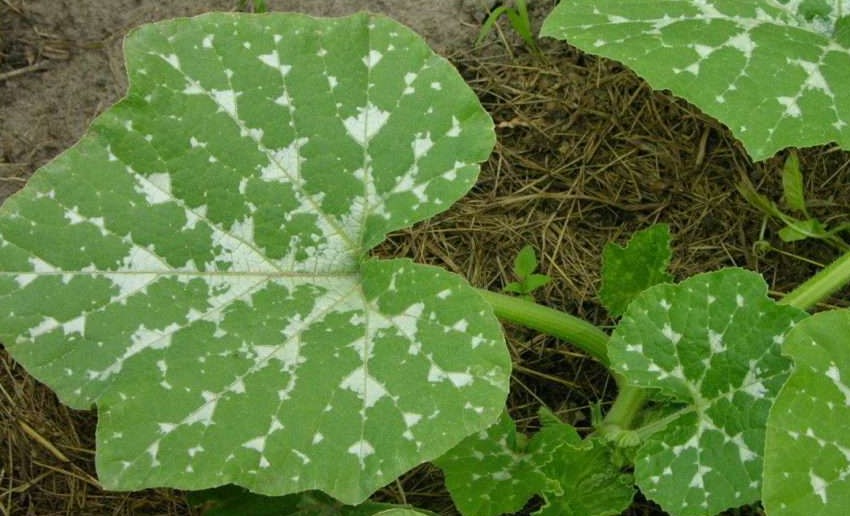
Harvesting the Fruit
Seems like all problems are behind and your mini-garden is growing, flowers turned into vegetables, and their color started to change according to the variety you have selected. The size of the fruit is big enough, the stems died, check the pumpkin for ripe.
Like with watermelon you can knock the fruit and hear the deaf sound, rind with a fingernail to see if it leaves the print – it is harvest time!
Overall, it takes about 100-120 days between planting seeds and harvesting time.
Storing
Store the vegetables in a warm place (under the bed for example) for several weeks to ensure a longer life span and then move it to a cooler place to be kept for a season or two.
Cooking pumpkins
Green and unripe vegetables can be used in delicious rare gourmet dishes in some exotic cuisines such as Indian for example. It might happen that you either grew the pumpkins later than required or they did not pollinate, but do not get disappointed earlier than there is a need.
There are many recipes for cooking pumpkins. Cooking includes pumpkin hummus, latte and pies, and numerous muffins made of pumpkin and soups and purees.
All you need is the patience of selecting from the list of dishes and carving technology to separate the inner side of the vegetable and seeds.
By the way, you can use seeds next year!
Keep the seeds clean, and dry in the special paper box in the darkness. Next year, take them out and pour them with water to wake them up and give you more fruits!

Some last tips
Plant seeds in the containers directly, without growing them into plants in small containers first.
Remember we told you about biodegradable pots, don’t you?
Male flowers show their colors first, do not confuse them when pollinating!
Wait for bees, but if more than two days after the flower opening, there are no bees around, handle the pollination yourself!
Flowers on the vines can physically bear one or two fruit – do not allow having more, as the weight will break the stems and you will lose all.
Heavy fruits should be supported not only by the sticks from the ground, but old stockings can be used to support the fruit hanging from the stem.
FAQ
- Can I grow a pumpkin in a large pot?The size of the container depends on the pumpkin variety you select to grow. Read the article above to choose the type of vegetable that suits you the best.

Conclusions
Anyone can grow a pumpkin, as this is the least capricious vegetable. It is tasty and easy to look after, even if you have limited space. The solution can be a plastic container or a pot of a suitable size for the chosen type of pumpkin you are planning to grow.
Pumpkins growing in a pot are not worse in taste than those in the garden. All you should consider is the process of planting, watering on time, pollination, and harvesting on time.
- Why Are There Still No Tomatoes in My Tomato Plants? Let’s Fix the Issue! - July 13, 2023
- Water Propagation White Stuff on Roots: Everything You Should Know! - July 11, 2023
- String of Dolphins Drying Up: Solved! - July 11, 2023
